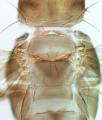Taeniothrips eucharii
Recognition data
Distinguishing features
Female macropterous; body colour brown, tarsi yellow, tibiae variable but yellow at least at apex although sometimes almost clear yellow; antennae brown with apex of segment III yellowish; fore wings brown with base pale. Antennae slender, 8-segmented, III & IV with apex narrowed and bearing forked sensorium. Head longer than wide, projecting slightly in front of eyes, cheeks convex but constricted behind eyes; posterior part of vertex transversely striate/reticulate, ocellar region without sculpture; 2 pairs of ocellar setae present, pair III as long as distance between compound eyes and arising on tangent between anterior margins of hind ocelli; postocular setae small. Pronotum without sculpture, with few discal setae, 2 pairs of long posteroangular setae; posterior margin with 2 pairs of small setae laterally and 1 pair of larger setae medially just in front of posterior margin. Fore tarsal pulvillus without recurved terminal tooth. Metanotum weakly reticulate, campaniform sensilla present, median setae arising close together at or near anterior margin. Mesofurca with spinula. Fore wing first vein with 1 seta medially and 2 nearer apex; second vein with complete row of about 10 setae. Tergites with no sculpture mesad of setae S2; VIII with posteromarginal comb of long regular microtrichia. Sternites without discal setae, setae S1 and S2 on sternite VII arising in front of margin.
Male smaller than female; tergite VIII with complete long comb, IX with 2 pairs of long dorsal setae with the lateral pair arising anterior to the median pair; sternites III–VII with broad pore plate.
Related and similar species
Currently there are 45 species listed in the genus Taeniothrips, although 21 of these are fossils. Of the remaining species, four are European in origin, one is from western North America, and the rest are from Asia. The Oriental species, T. eucharii, is particularly similar to T. picipes, the European type species of the genus, but has antennal segment III a much darker brown colour. T. inconsequens has a terminal claw on the fore tarsus, and the metanotal median setae further apart.
Taxonomic data
Current valid name
Taeniothrips eucharii (Whetzel)
Original name and synonyms
- Physothrips eucharii Whetzel, 1923: 30
- Taeniothrips gracilis Moulton, 1928: 289
- Taeniothrips rohdeae Kurosawa, 1937: 273
Family placement
Thripidae, Thripinae
Common names
Oriental lily-flower thrips
Biological data
Life history
Breeding on leaves, but also found on bulbs and in flowers.
Host plants
Various Liliaceaeand Amaryllidaceae, including Crinum, Eucharis, Hymenocallis, Liriope, Lycoris, Narcissus, Zephyranthes.
Tospoviruses vectored
None
Crop damage
Usually no more than minimal discolouration around leaf bases of lilies.
Distribution data
Area of origin
Presumably eastern Asia
Distribution
Described from Bermuda, but recorded from Korea, China, Taiwan, Malaysia, Japan, Hawaii, Netherlands and northern Australia (Mound & Tree, 2008). Likely to be introduced to California by the horticultural trade in lilies.







